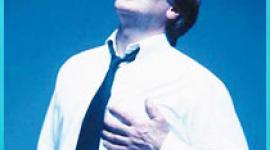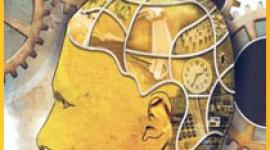Panic Attacks: Introduction
Welcome toThe Basics About Panic Attacks - Introduction
Home Study
- Don't Panic,
Chapter 3. Panic within Psychological Disorders
 Although the first panic attack may seem to appear "out of the blue," it typically comes during an extended period of stress. This stress is not caused by a few days of tension, but extends over several months. Life transitions, such as moving, job change, marriage, or the birth of a child, often account for much of the psychological pressure.
Although the first panic attack may seem to appear "out of the blue," it typically comes during an extended period of stress. This stress is not caused by a few days of tension, but extends over several months. Life transitions, such as moving, job change, marriage, or the birth of a child, often account for much of the psychological pressure.
For some individuals, learning to manage this stressful period or to reduce the pressures will eliminate the panic episodes. For others, it is as though the stress of the life transition or problem situation uncovered a psychological vulnerability. If the panic-prone individual accepts increased responsibilities -- for instance, through a job promotion or through the birth of a first child -- he may begin to doubt his ability to meet the new demands, the expectation of others, and the increased energy required for these responsibilities. Instead of focusing on mastering the task, he becomes more concerned with the possibility of failure. This attention to the threat of failure continually undermines his confidence. Either gradually or quickly, he translates these fears into panic.
Certain people experience symptoms in the middle of sleep. These are either caused by panic disorder or are identified as "night terrors". Most nighttime (or nocturnal) panics take place during non-REM sleep, which means they do not tend to come in response to dreams or nightmares. They occur between a half-hour to three and a half hours after falling asleep and are usually not as severe as daytime panics. These are distinct from night terrors, known as pavor-nocturnus in children and incubus in adults. The similarities are that they produce sudden awakening and autonomic arousal and tend to not be associated with nightmares. However, a person who experiences a night terror tends to have amnesia for it and returns to sleep without trouble. He also can become physically active during the terror -- tossing, turning, kicking, sometimes screaming loudly or running out of the bedroom in the midst of an episode. Nocturnal panic attacks, however, tend to cause insomnia. The person has a vivid memory of the panic. He does not become physically aggressive during the panic attack, but remains physically aroused after the occurrence.
WHAT IS AGORAPHOBIA?
Each person diagnosed with agoraphobia (meaning "fear of the marketplace") has a unique combination of symptoms. But common to all agoraphobics is a marked fear or avoidance either of being alone or of being in certain public places. It is a response strong enough to significantly limit the individual's normal activities.
For the person who experiences panic attacks, the distinction between agoraphobia and panic disorder is based on how many activities he avoids. In panic disorder, the person remains relatively active, although he may avoid a few uncomfortable situations. If the panic-prone person begins to significantly restrict his normal activities because of his fearful thoughts, agoraphobia is the more appropriate diagnosis.
For some, agoraphobia develops from panic disorder. Repeated panic attacks produce "anticipatory anxiety," a state of physical and emotional tension in anticipation of the next attack. The person then begins to avoid any circumstances that seem associated with past panic attacks, becoming more and more limited in his range of activities.
The fearful thoughts that plague the agoraphobic often revolve around loss of control. The person may fear the development of uncomfortable physical symptoms familiar from past experiences (such as dizziness or rapid heartbeat). He may then worry that these symptoms could become even worse than they were in the past (fainting or heart attack), and/or that he will become trapped or confined in some physical location or social situation (such as a restaurant or party). In the first two situations, the person senses that his body is out of control. In the third, he feels unable to readily control his surroundings.
The following list shows the types of surroundings that can provoke these fears.
FEAR OF THE SURROUNDINGS
- Public Places or Enclosed Spaces
- Confinement or Restriction of Movement
- Streets
- Barber's, hairdresser's, or dentist's chair
- Stores
- Lines in a store
- Restaurants
- Waiting for appointments
- Theaters
- Prolonged conversations in person or on the churches, phone
- Crowds
- Travel
- On trains, buses, planes, subways, cars
- Over bridges, through tunnels
- Being far away from home
- Remaining at Home Alone
- Open Spaces
- Traffic
- Parks
- Fields
- Wide streets
- Conflictual Situations
- Arguments, interpersonal conflicts, expression of anger
The agoraphobic may avoid one or many of these situations as a way to feel safe. The need to avoid is so strong that some agoraphobics will quit their jobs, stop driving or taking public transportation, stop shopping or eating in restaurants, or, in the worst cases, never venture outside their home for years.
Listed below are the types of fearful thoughts associated with the dreaded situations. These are irrational, unproductive, and anxiety-producing thoughts which last anywhere from a few seconds to more than an hour. At the same time, they are the primary cause of agoraphobic behavior. These thoughts serve to perpetuate the agoraphobic's belief: "If I avoid these situations, I'll be safe."
FEARFUL THOUGHTS
- Fainting or collapsing in public
- Developing severe physical symptoms
- Losing control
- Becoming confused
- Being unable to cope
- Dying
- Causing a scene
- Having a heart attack or other physical illness
- Being unable to get home or to another "safe" place
- Being trapped or confined
- Becoming mentally ill
- Being unable to breathe
Some agoraphobics experience no symptoms of panic. Fearful thoughts continue to control these individuals, but they have restricted their lifestyle, through avoidance, to such a degree that they no longer become uncomfortable.
When agoraphobics retreat to protect themselves, they often have to sacrifice friendships, family responsibilities, and/or career. Their loss of relationships, affections, and accomplishments compounds the problem. It leads to low self-esteem, isolation, loneliness, and depression. In addition, the agoraphobic may become dependent on alcohol or drugs in an unsuccessful attempt to cope.
Professional Help
Panic disorder is the only psychological problem whose predominant feature is recurring panic (or anxiety) attacks. The following is a brief summary of professional treatment of this problem.
One of the most difficult problems for individuals with panic disorder is getting the right diagnosis. Panic disorder is regarded as one of the great impostors of medicine because its symptoms are similar to those found in a number of physical ailments, including heart attacks, some respiratory illnesses and thyroid diseases. Once diagnosed and proper treatment begun, recovery may occur in a matter of months, but can take longer depending on individual circumstances.
The most successful treatment regimens include a combination of behavior therapy and cognitive therapy, sometimes with medication. Support groups may also be extremely useful, because many individuals need the reassurance that they are not alone. A successful treatment program must address all the individual's problems, including depression or substance abuse, that might accompany the underlying emotional disorder.
Cognitive-behavior therapy attempts to alter the way a person thinks and acts in certain circumstances. Specifically, the therapist helps the patient develop anxiety reduction skills and new ways to express emotions. Relaxation techniques, such as controlled breathing, are a typical feature. The patient also may be taught to re-examine the thoughts and feelings that trigger his fears and maintain his anxiety. The patient often is gradually exposed to the feared situation, and taught that he can cope.
There are a number of anti-anxiety and antidepressant medications that can be effective in controlling panic disorder. The medication regimen may last just a few weeks, but in many cases this therapy may be required for a year or longer. Medication should be accompanied by other therapy, however, because the majority of patients treated only with drugs relapse once the medication is discontinued.
next: Change Your Attitude! Change 1
~ back to Anxieties Site homepage
~ anxiety-panic library articles
~ all anxiety disorders articles
APA Reference
Staff, H.
(2009, January 4). Panic Attacks: Introduction, HealthyPlace. Retrieved
on 2025, November 24 from https://www.healthyplace.com/anxiety-panic/articles/basics-about-panic-attacks



